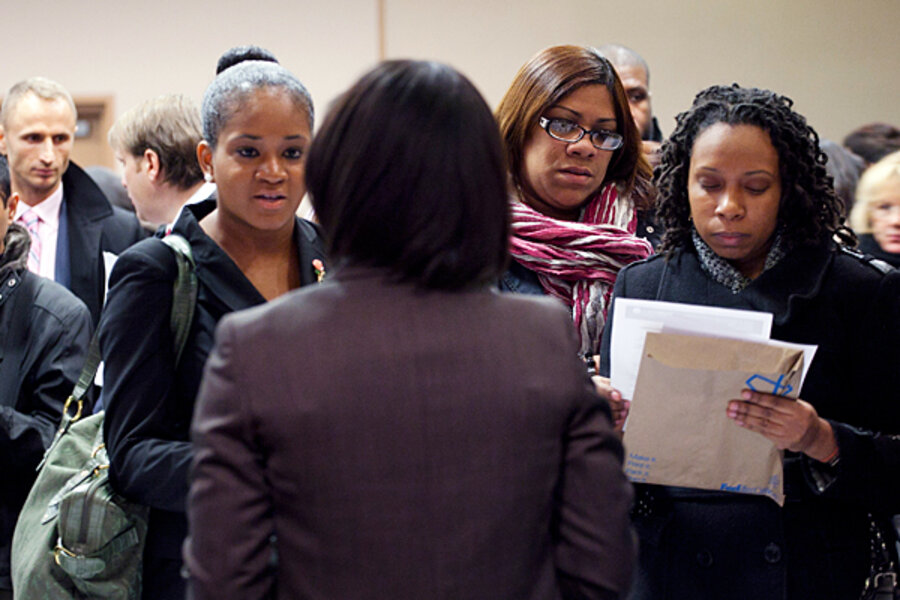Unemployment rate falls to 8.5%; GOP still using jobs as battering ram
Loading...
With 11 months to go before the presidential election, the economy has finally started to produce more jobs.
The economy added 200,000 new jobs in December, the best showing since last spring, the Department of Labor reported Friday. The unemployment rate fell from 8.7 percent to 8.5 percent, its lowest level since February 2009.
The better jobs numbers immediately touched off a spate of claims from both political parties. The Obama White House said they indicate that the economy is continuing to “heal” from the worst downturn since the Great Depression. Republicans called the 8.5 percent jobless rate “shockingly high.”
Economists say the better data indicate the US economy is gradually improving, perhaps a sign that private businesses are becoming more confident. However, corporate confidence is tempered as executives watch events in Europe, where a recession may already be under way, and keep a wary eye on what is expected to be a relatively high level of foreclosures in the US for months to come.
[ Video is no longer available. ]
“We need a lot stronger job gains for a longer period of time before we can say we have moved out of recovery and into full expansion mode,” says Joel Naroff of Naroff Economic Advisors in Holland, Pa.
The improvement in the jobs report was broad-based, with gains in transportation (50,000 new jobs), retail (28,000), manufacturing (23,000), health care (23,000), and food and leisure (24,000). Government jobs continued to be a drag on the economy, with a loss of 12,000 jobs in December.
The better numbers, economists say, may reflect recovery from many of the negative factors that had kept growth low: the earthquake and tsunami in Japan, which hurt the auto sector; the summer uncertainty as Congress debated raising the national debt ceiling; and the continuing saga in Europe over sovereign debt.
“It appears we are now back on track,” says John Canally, chief economist at LPL Financial in Boston. “Fed Chairman Ben Bernanke has said the economy was a little bit unlucky; now, maybe we’ll have a run of months without any bad luck.”
Improvement in the unemployment rate may also reflect a shift in the number of people looking for work. The total labor force has been steadily shrinking, observes Mr. Naroff. “This may indicate there are a lot of frustrated workers out there, or maybe people coming off the unemployment rolls because they have run out of benefits and are taking some time off, or maybe baby boomers starting to retire,” he says. “But I don’t think we need to be alarmed by this.”
Despite the jobs improvement, the economy still has a long way to go to make up the 8.9 million jobs that were lost in the recession. At the current rate, it would take about seven more years – until about 2019 – to get back to the prerecession unemployment rate, writes Heidi Shierholz, an economist at the Economic Policy Institute, a think tank in Washington.
Politicians were quick to interpret the new numbers to buttress their own views on the state of the economy. Democratic House leader Nancy Pelosi of California, saying in a statement that the report shows a step in the right direction, castigated Republicans for precipitating an unnecessary crisis over the debt ceiling “that hurt our middle class.”
Representative Pelosi, as well as the White House, called on Congress to approve a full-year extension of the payroll tax cuts. Late last year, lawmakers agreed to extend the tax cuts until the end of February.
Many Republicans, in the meantime, are now using 8 percent as the benchmark to measure President Obama’s prowess on the economy. The last time the unemployment rate was below 8 percent was in January 2009, the first month of Mr. Obama’s presidency. House Speaker John Boehner of Ohio noted that the unemployment rate has been above 8 percent for 35 consecutive months. He blamed the White House and the Democratic-controlled Senate for creating uncertainty by failing to enact the full-year extension of the payroll tax credit.
“The House has passed nearly 30 jobs bills that remain stuck in the Democratic-controlled Senate,” he said in a statement.
Despite the political rhetoric and the economic uncertainties, some companies are contemplating adding workers in 2012, says Joanie Ruge, New York-based chief employment analyst at Randstad Holding, a large staffing company.
“We are having some conversations with companies that are talking about making some pretty big hires,” says Ms. Ruge. “We are talking about Fortune 1000 companies that may need to hire a lot of people.”
Ruge’s company is also in the temp business, which actually saw a decrease in hiring in December. That's was somewhat worrisome, economists say, because the temp industry often is a leading indicator of employment trends.
However, the drop in temp hiring, at least as far as Ruge's company is concerned, came about because companies converted the temps to full-time employees. “They wanted to get people employed and on their books before the end of the year,” she says. “But we will need to see that negative growth on temp hiring reverse in the future.”





